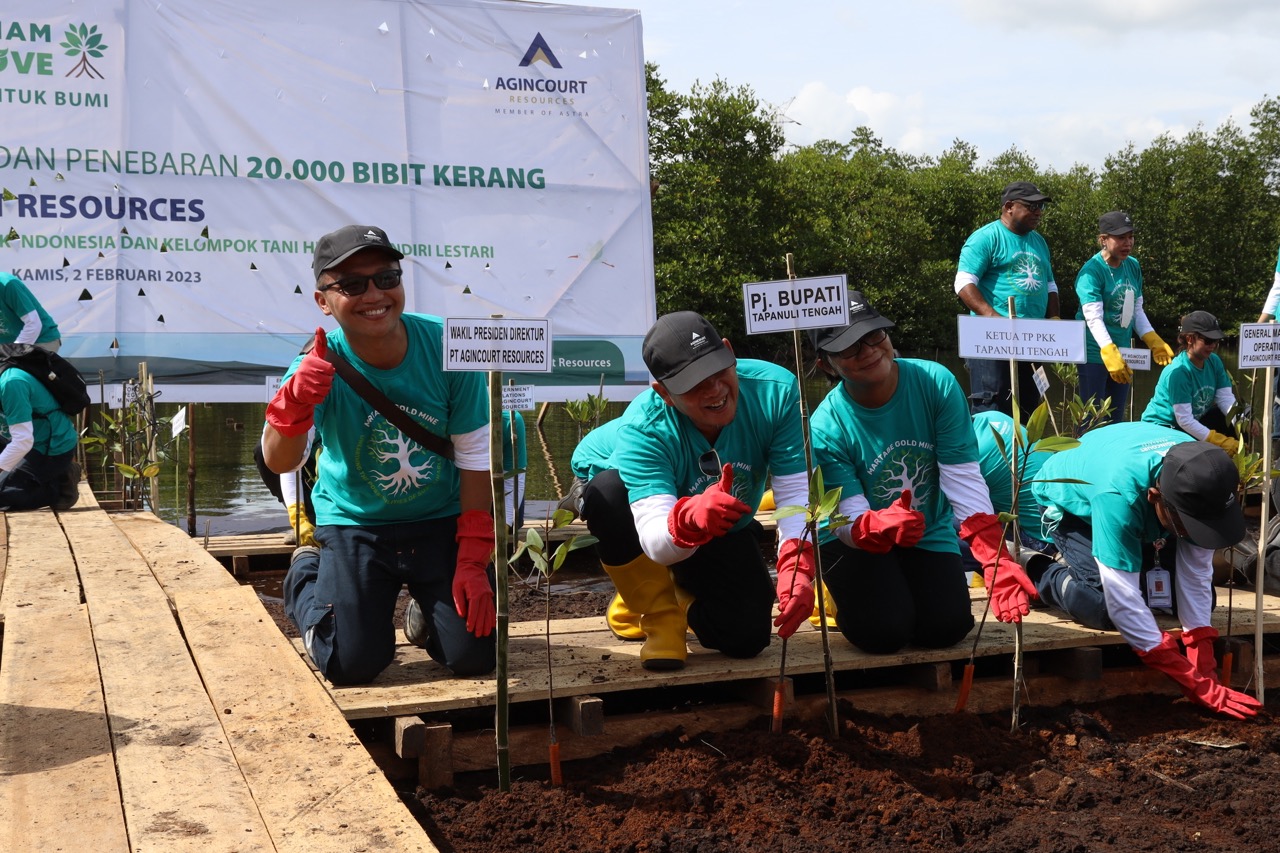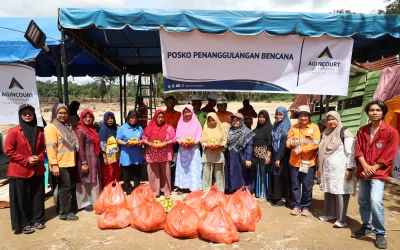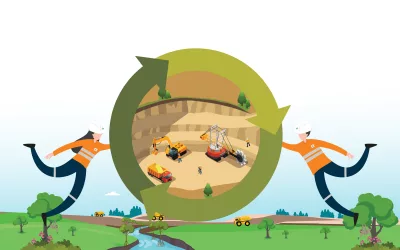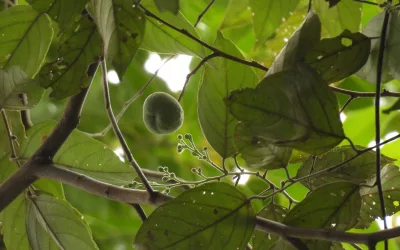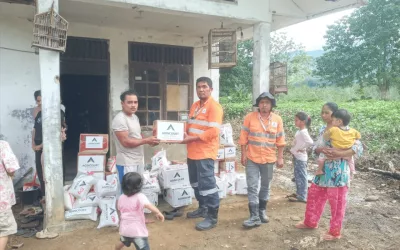The mangrove forests in North Sumatra are in critical condition due to severe seawater abrasion causing harm to settlements, infrastructure, and biodiversity. The threat of seawater abrasion is terrible, especially in the districts of Mandailing Natal, Langkat, Deliserdang, and Central Tapanuli. Settlements, public and social infrastructure have suffered harm due to the coastal damage that has already reached over 15 kilometers. The destruction of mangrove forests not only has visible effects but also affects the local climate and biodiversity. This situation requires immediate action to prevent further damage.
In 2022 President Joko Widodo instructed to allocate part of the budget to the Environmental Fund Management Agency (BPDLH) to improve mangrove land and waste management. “We need to be focused there (in mangrove) because we have a lot of mangrove land that we really have to repair, concentrate there,” said the President on the Presidential Secretariat’s YouTube channel.
Read Also: Planting Mangrove Seeds, PTAR Preserves the Central Tapanuli Coastal Area
During a 2022 interview on the Presidential Secretariat’s YouTube channel, Indonesian President Joko Widodo urged the Environmental Fund Management Agency (BPDLH) to allocate a portion of its budget towards enhancing mangrove land and waste management. The President emphasized the importance of focusing on repairing the vast amount of mangrove land in the country. “We must concentrate (our effort) there because we have a lot of mangrove land that we really have to repair, concentrate there,” said the President.
Although it has nothing to do with the president’s call, PT Agincourt Resources (PTAR) has recently planted 30,000 mangrove seedlings and released a total of 20,000 locust shells in Aek Garut village, Pandan District, Central Tapanuli. This initiative is a testament to PTAR’s unwavering dedication to participating in environmental conservation efforts for the sake of sustainability, regardless of any external factors or calls to action.
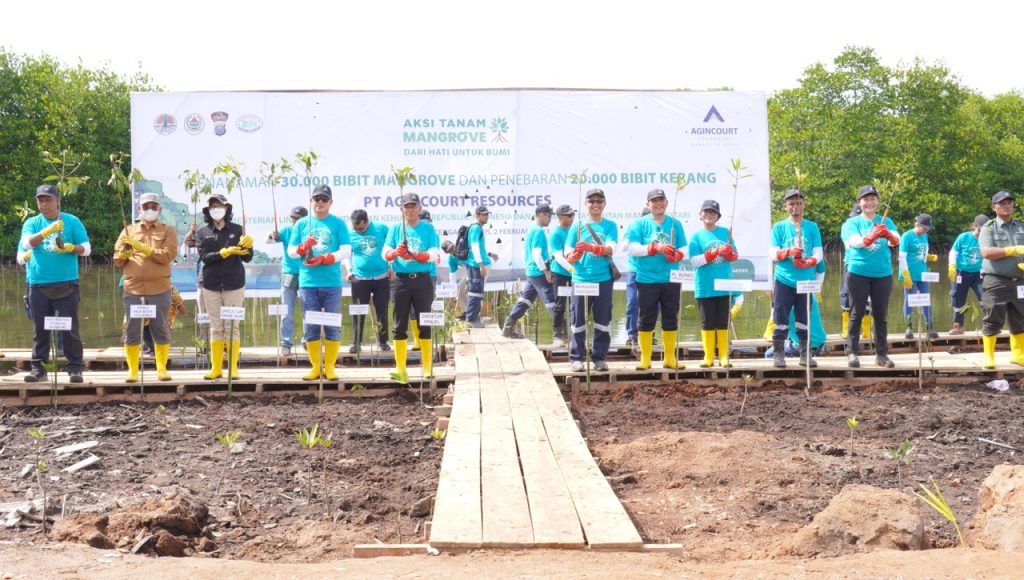
Read Also: Conserving Central Tapanuli Coastal Area Agincourt Resources Plants 30,000 Mangrove Seedlings
Mangroves for Sustainable Development
Deputy President Director of Agincourt Resources, Ruli Tanio said that the act of planting mangrove trees was one of Agincourt’s steps in seeing the future which must involve sustainable growth.
“Everyone wants a better life and that requires a better environment. A better life will not happen if the environment’s carrying capacity is not supportive,” he explained to the media crew.
Ruli stated that PTAR is dedicated to ensuring the sustainable maintenance of the earth by taking small but significant steps. When it comes to the cessation of operations at the Martabe gold mine, the company is resolute in its hope that the surrounding area will thrive with an abundance of diverse flora and fauna, creating a fully functional ecosystem.
Read Also: Agincourt Resources Undertakes In-situ Conservation for Native Plants in Batangtoru
Apart from planting mangrove trees, PTAR also delivered a total of 20,000 locust shells to establish a thriving and rejuvenated ecosystem. PTAR is committed to ensuring the longevity of the planet by reviving the biodiversity and ecosystem functions in the surrounding area of the Martabe gold mine.
“We always move from one program to another, seriously embodying those that have a good impact on society,” said Ruli. Ruli hopes that the company’s actions will receive a positive response from all stakeholders so they can collaborate to make Indonesia a better place.
Director of Conservation of Species Biodiversity and Genetics of the Ministry of Environment & Forestry, Drh. Indra Exploitasia, M.Si. also appreciated what PT Agincourt Resources had done while celebrating World Wetland Day.
“In this case, the ministry is also contributing to the seeds and will carry out preservation to maintain the existing biodiversity,” he said. It should be noted that Indonesian mangroves are the widest and largest mangroves in the world with an area of around 3.6 million hectares. As an archipelagic country with one of the world’s longest coastlines and a tropical climate, Indonesia depends on these forests to maintain land area and ecological balance.
Mangroves or mangrove forests are specific plant formations that grow and develop in sandy areas in tropical and subtropical regions. As quoted from the journal Oceana Vol. XXVI No. 4, the word mangrove comes from a combination of the Portuguese “mangue” and the English “grove”.
Read Also: Mining and Forest Reclamation Absolute Rules
Mangrove trees, known as Rhizophora, from the genus Rhizophora, tribe Rhizophoraceae, have large woody roots, shoots covered with tapered stilts, and viviparous fruits that germinate and take root while still on the tree. They have many other names depending on the region, such as tancang, tanjang, tinjang, bangko, kawoka, wako, jangkar, and others. According to www.kkp.go.id, Indonesia has around 3,490,000 hectares, or 20% of the world’s mangrove forest area.
Of the 3.5 million hectares, more than 600 thousand hectares of mangrove forests are in critical condition. Immediate action is necessary to prevent destruction. What PTAR is doing by planting 30,000 mangrove seedlings may seem small and insignificant, but it is essential. Mangrove forests play an important role in the ecosystem as well as human life. Mangrove forests are vital for the ecosystem and human life. They protect coastal land from sea waves, produce oxygen, absorb carbon dioxide, and provide a habitat for marine life such as small fish species, including clams, shrimp, crabs, and other marine animals.
Read Also: Protecting Batangtoru Forest Biodiversity Agincourt Resources Holds Fauna Inspection Training
Various Benefits of Mangrove Forests
Mangroves protect both the saltwater and the freshwater ecosystems they straddle. The mangroves’ complex root systems filter nitrates and phosphates that rivers and streams carry to the sea. Realizing the significant role of mangroves for the ecosystem, PTAR also spread shellfish seeds to stimulate the growth of the local ecosystem.
The preservation of mangrove forests is crucial for the survival of the ecosystem, many animals rely on this mangrove forest for shelter, food, and breeding – even seabirds and shellfish contribute to the ecosystem by fertilizing the soil and attracting other marine life. Moreover, mangroves serve as crucial spawning and breeding grounds for marine animals. It is imperative that we take action to preserve these forests for the benefit of our planet’s ecosystem
Thus, PTAR has directly pioneered the formation of a new ecosystem. As mangrove seedlings grow into mangrove forests, they will attract animals to find food, shelter, and breeding grounds. Such a process will form an ecosystem and the biodiversity in the mangrove forest will gradually increase.
Mangrove forests, like other forest types, have various roles such as filtering seawater to maintain fresh water on land, holding back waves of water and wind from the sea so as to protect land, beaches, and rivers, and preventing mud accumulation to protect marine ecosystems. Mangrove forests are also a source of food for plankton and provide sustainability of the food chain, spawning, and breeding grounds for various types of fish, shellfish, crabs, shrimp, and other marine animals. Mangroves are also shelters, nesting, and breeding grounds for various species of birds and other animals, sources of germplasm and genetic resources, and are natural habitats for various types of biota.
Valuable materials can be obtained from mangrove forests, such as mangrove tree logs which can be used as fuel for charcoal and building materials. Wood from mangrove forests can also be used as raw material for pulp for paper or textiles. Mangrove forests can produce ingredients for cosmetics, medicines, textile dyes, and paper.
The unique root system of mangrove trees allows them to grow in both land and sea, making them resistant to low-oxygen environments. Mangrove plants have a prominent root system to support life in two realms, in contrast to tree roots on land, mangrove roots are known as breathing roots or pneumatophores. This system makes mangroves more resistant in minimum oxygen levels environments, and with its denser, and more complex root system, mangroves are capable of precipitating the remaining organic matter carried by water from the land to the sea. These deposits provide various minerals and food solutions for marine biota and also can form land in the long term.
Mangroves’ reproduction system is by dropping their seeds into the water where they are carried slowly into new areas. These seeds eventually grow and form new colonies, which over time can result in the creation of new islands or land. The roots of mangroves also filter the water, making it cleaner and clearer.
Planting Trees, Reducing the Impact of Global Warming
During the event of “Dari Hati Untuk Bumi” in Aek Garut, PTAR empowered the Mandiri Lestari Farmers group, a local farmer group with three years of experience in cultivating mangrove seeds. The group prepared mangrove seeds of local Rhizophora species, ready for planting with an age range of 4 to 6 months in nurseries with tree heights of 50-80 centimeters. While the shell seeds released in the mangrove forest were of locust species in ready-to-release, healthy, and fresh conditions. The seeds were planted 1 x 3 meters apart while considering the low tide limit. It is estimated that the planting process will take around 2 to 3 months with a maintenance and supervision period of 2 years and could be extended if necessary.
Despite an occupancy of 20% of the world’s mangrove land in Indonesia, the calculated mangrove forests are decreasing over time. About 15 to 20 years ago, the area of mangrove forests in Indonesia was still around 8 million hectares. The distribution of mangroves is on the coasts of Sumatra, Kalimantan, and Papua and the land area continues to decrease. It’s an imminent and present danger if we look at the numbers, from 8 million hectares to 3.5 million hectares. This is certainly an alarming value since Indonesia lost around 5 million hectares of mangrove land in just 20 years!
Read Also: Disaster Mitigation Due to Global Warming by Building Mangrove Ecosystems
Due to the rapid destruction of mangrove forests in Indonesia, it is imperative that all sectors of society, including the government, private sector, and influential community figures, come together to address this issue. These influential figures, such as religious and traditional leaders, should play a significant role in educating the public on the importance of mangroves, particularly for those who still adhere to feudalism.
Strict law enforcement must be applied to those who destroy mangrove forests. However, it must be applied wisely and not selectively. Perpetrators should not be processed quickly just because they are unimportant, while important people tend to be silenced. An example of the symbiotic concept of mutualism is the development of mangrove forests into tourist attractions, giving the local community full authority as managers. This practice has been applied in various regions on the islands of Java and Sumatra.
By cultivating fish and crabs in mangrove forests, PTAR also supports the welfare of the community, thus promoting mutualism between the forests and the local community. The action has multiple advantages like preventing the effects of climate change and supporting the local community by providing economic benefits from mangrove forests. This mutual connection will bring up protection from the local community for the mangrove forests.
The action for environmental conservation does not stop at mangrove forests. PTAR with the local community and related parties planted 1,000 productive tree seedlings in November 2022 in the Garoga River Basin which flows through Batang Toru District, South Tapanuli. The trees planted are productive and have economic value species like durian, avocado, mango, and trembesi. Thus, PTAR hopes that besides being able to protect the Garoga River ecosystem, these trees can also provide economic benefits for local residents.
Read Also: Commemorating Indonesian Tree Planting Day, PTAR Engages People to Care for the Environment
In June of the same year, PTAR also initiated an activity to plant 200 tree seedlings in the Batang Toru Mining Vocational School school area. PTAR also handed over 1,200 tree seedlings to the community around the Martabe gold mine area. PTAR has planted more than 41 thousand tree seedlings with the potential for carbon sequestration of 1 million tons and oxygen production of around 18 million kilograms per year.

